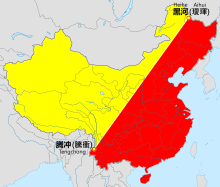Heihe–Tengchong Line

The Heihe-Tengchong Line (simplified Chinese: 黑河-腾冲线; traditional Chinese: 黑河-騰沖線; pinyin: Hēihé-Téngchōng xiàn), also called the Aihui-Tengchong Line, is an imaginary line that divides the area of China into two roughly equal parts. It stretches from the city of Heihe (Chinese: 黑河; pinyin: Hēihé) to Tengchong County (simplified Chinese: 腾冲; traditional Chinese: 騰沖; pinyin: Téngchōng) diagonally across China.
Chinese population geographer Hu Huanyong discovered the line in 1935 and called it a "geo-demographic demarcation line".
This imaginary line divides the territory of China as follows (going by 1935 statistics):
- West of the line: 57% of the area, but only 4% of the population (1935)
- East of the line: 43% of the area, but 96% of the population (1935)
According to 2002 statistics they are as follows:
- West of the line: 57% of the area, but only 6% of the population (2002)[1]
- East of the line: 43% of the area, but 94% of the population (2002)[1]
Although more than 70 years have passed since 1935, the modern statistics remain very close to the original numbers. The territory has not changed but the population has slightly shifted from east to west.
The slight change in population is attributed to Han Chinese migration to urban areas in autonomous regions of Tibet and Xinjiang. However, the west side of the He ihe-Tengchong Line still remains relatively rural and poor as compared to the east.
